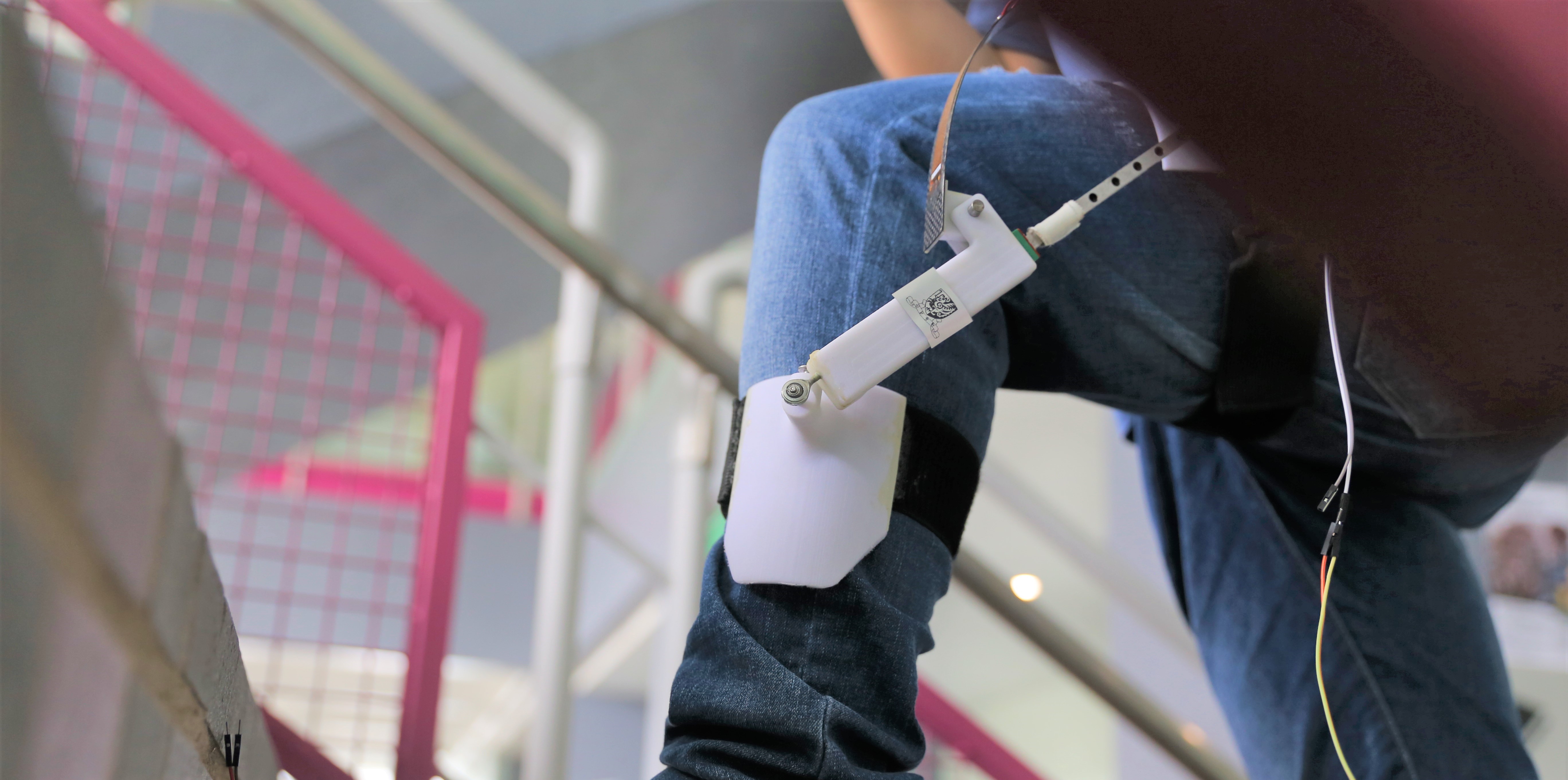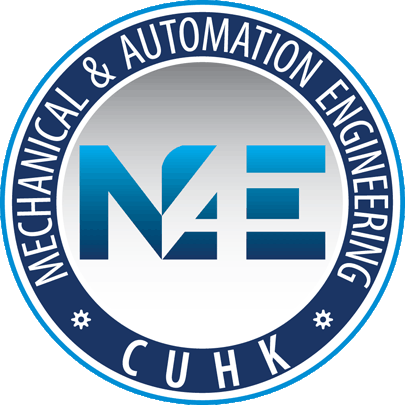 Programme Features
Programme FeaturesThe curriculum covers the fundamental knowledge in the areas of mechanical and automation engineering, including mechanics and materials, thermodynamics, control, manufacturing, and electronics. Students can pursue more in-depth knowledge in the subjects of their choices, such as computer-aided design and graphics, robotics, mechatronics, intelligence system, engineering optimization and MEMS. Students may choose to specialize in one of the following three streams or not to specialize in any stream:
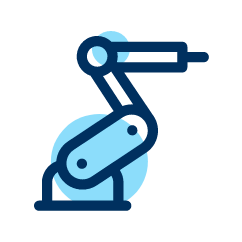
Design and Manufacturing
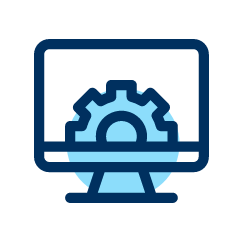
Mechatronics
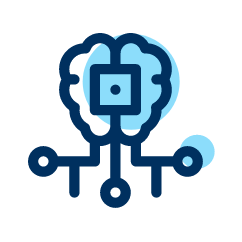
Robotics and Automation
 Admission
AdmissionJUPAS Code: JS4408
Admission is based on the Best 5 HKDSE subject results with subject weighting. For details of minimum admission requirement and subject weighting, please refer to the table below. This is applicable to HKDSE applicants for 2024-25 onwards.
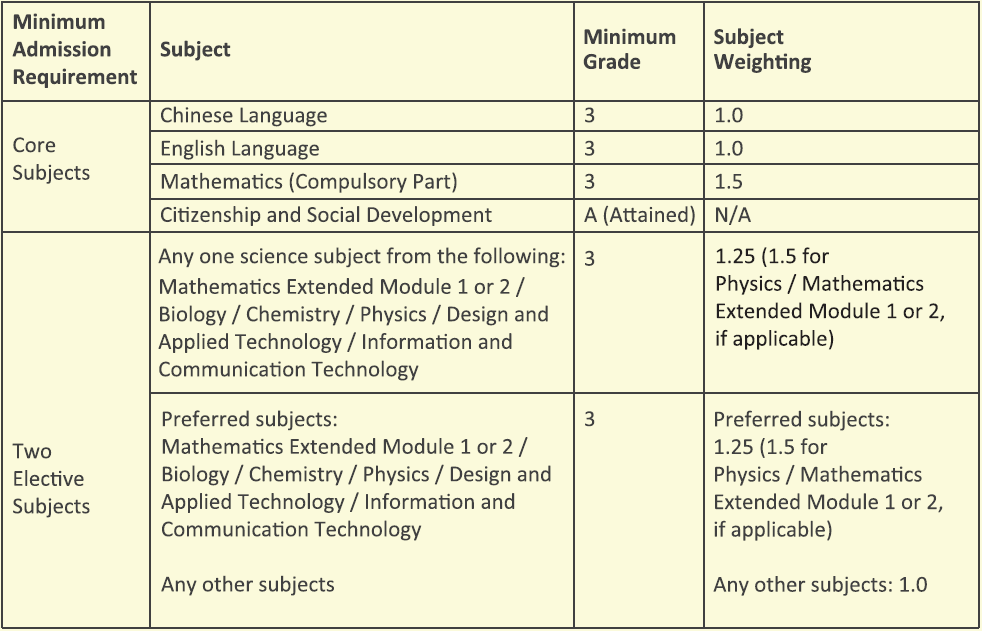
The programme accepts “Attained with Distinction I or II” in Applied Learning subjects as extra elective subject for awarding bonus points. Please refer to https://www.cuhk.edu.hk/adm/jupas/ApL for details.
Interview for JUPAS applicants will be arranged on a selective basis.
Local Entrants
- Non-JUPAS (Local) Admission Scheme*: Local students who possess post-secondary qualifications such as International Baccalaureate, GCE A-Level, SAT, Higher Diploma and Associate Degree can apply for admission to the programme. Click here for details.
International Entrants*
- Students requiring a student visa to study in Hong Kong can apply for admission to the programme by using post-secondary qualification such as International Baccalaureate, GCE A-Level and SAT. Click here for details.
Mainland Entrants
- Click here for details
 4-year Curriculum (Applicable for students admitted in 2024-25)
4-year Curriculum (Applicable for students admitted in 2024-25)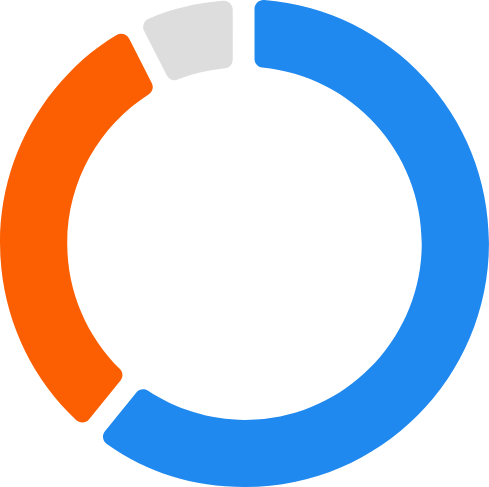
123 units
Free Electives
9 units
University Core Requirements
39 units
Major Programme Requirements
(Breakdown as follows)
75 units
This course introduces fundamentals of materials including atomic bonding; crystal structures, defects; mechanical properties of materials, phase diagram; overview of metals, alloys, ceramics, polymers, semiconductors and composites; electrical, optical, magnetic, and thermal properties of materials; materials selection and design considerations for engineering technologies. Applications of materials to energy and environmental engineering, mechanical engineering, medical engineering, and others will be discussed.
This is an introductory course on electric circuits. The main content includes basic circuit laws and theorems, methods of circuit analysis, operational amplifier circuits, and the concept of linear feedback system. The basic concepts of AC circuits, including impedance, phasors, sinusoids and frequency response, will be taught. The course will also cover the fundamentals of electrical power systems, including transient analysis, three-phase circuits, inductors and transformers, and basic electromechanical principles. This course includes mandatory laboratory modules.
This course provides an introduction to the statics and dynamics. You will be introduced to and become familiar with all relevant physical properties and fundamental laws governing the behavior of particles and rigid bodies, and you will learn how to solve a variety of problems in terms of kinematics, kinetics, energy, and momentum of particles and rigid bodies. The emphasis is on the physical understanding of why particles or rigid bodies behave the way they do in both the statics and the dynamics.
This course will cover fundamental topics in thermodynamics including basic concepts, heat and work, pure substance, ideal gas, first law and second law of thermodynamics, entropy, gas and vapor power cycles, and refrigeration cycles.
This course introduces basic and fundamental knowledge in technology, engineering, and their impacts on human society. Important and various aspects of engineering will be introduced, like engineering design and innovation, engineering project management, and intellectual property. Student have opportunities to participate some field study to have a better understanding of engineering design, innovation, and industrial manufacturing in practice. This course also provides several seminars given by real engineers with topics on current engineering issues, career decision-making strategies, and opinions such as internships and life-long study.
This course is a study of mechanics of materials. It covers the following topics: linear elasticity, stress and strain, stress-strain relations, loading and deformation, statically indeterminate problems, torsion, shear forces and bending moments, stresses in beams, deflection of beams, stresses in thin-walled pressure vessels, column and buckling.
This course provides students with fundamental background of manufacturing technologies. It covers the following topics: overview of manufacturing technologies, engineering materials, metal forming processes, plastic forming processes, 3D printing processes, machining processes, micro-manufacturing and fabrication. A number of industrial visits and hands-on labs are also included.
This course covers important topics in fluid mechanics. It will introduce the nature of fluids; pressure, hydrostatics, and buoyancy; integral and differential equations of fluid flows; conservation of mass, momentum, and energy; basic mass transfer; inviscid flow, viscous-dominated flows; Navier-Stokes equation; dimensional analysis; internal and external flows, boundary layers, and lift and drag on objects.
This course covers the engineering design principles, machine design methods, design of machine components, and kinematics. Load analysis, design for manufacturing, reliability and human factors will also be introduced and reviewed.
This course provides students with fundamental knowledge of control systems. It covers the following topics: mathematical modelling and linear approximation of engineering systems, Laplace transform, transfer function and block diagram representation, characteristics of feedback systems, performance specifications, Routh-Hurwitz stability criterion, root locus design, frequency response design and Nyquist criterion. The utilization of computer-aided analysis and design software is also included.
This course will cover fundamental topics in heat transfer including physical origins of three heat transfer modes and their rate equations, heat diffusion equation, boundary and initial conditions, steady-state and transient conduction, numerical methods, boundary layer equation, external and internal forced convection, free convection, and thermal radiation.
The course is designed to provide students with an opportunity to carry out, under the supervision of an academic staff, an independent project with research elements in engineering.
The course is designed to provide students with an opportunity to carry out, under the supervision of an academic staff, an independent project with research elements in engineering.
This course aims to provide an intensive hands-on introduction to the C++ programming language. Topics include the basic C++ language syntax, variable declaration, basic operators, program flow and control, defining and using functions, file and operating system interface. Specific key features of the C++ programming language such as object-oriented methodology, class templates, encapsulation, inheritance, polymorphism, etc. will be highlighted.
This course provides a broad overview of microfabrication and microelectromechanical systems. Topics include introduction to basic micromaching techniques such as photolithography; isotropic and anisotropic wet etching; dry etching; physical and chemical vapor deposition; electroplating; metrology; statistical design of experiments; MEMS release etching; stiction; and MEMS device testing. The course also reviews important microsensors, microactuators and microstructures. Topics include accelerometers; pressure sensor; optical switches; cantilever beams; thin-film stress test structures and bulk micromaching test structures. Lastly, the course introduces the fundamentals of central dogma of molecular biology; cell and tissue biology; and principles of transduction and measurements of molecules, cells and tissues.
This course introduces engineering design and design procedure, design innovation and TRIZ, axiomatic design, nature’s design and complex systems, design analysis (modeling and simulation), statistical analysis, design optimization, statistical design optimization, and Design for Six Sigma (DFSS). Practical examples of design and applications are provided in the course such as pendulum, bicycle, windmill and propulsion.
This course is aimed to enhance students’ professional and engineering interests through practicum and team-based development of practical robots through participation in hands-on competitions. This is a project-based experiential course that exposes students to design and build practical robots. Students will be required to conceptualize and perform high-level design of a robot system, and then design and build various components using skills including CAD drawing, mechanical structure, electronic circuits and programming skills. Students will practice their engineering knowledge through tutorial-style workshops and laboratory sessions. The goal is to develop and nurture skills in problem-solving, hands-on skills, project and time management through the project. Students should obtain approval from the course instructor to ensure that the participated activities are in-line with the course learning outcomes.
The course covers the basic and fundamentals to the study of robotic manipulators, including: classification of robots, robot sensors and actuators, coordinate frames and homogeneous transformations, Denavit-Hartenberg notation, forwards and inverse kinematics, Jacobians and statics, singularity and workspace analysis, and trajectory generation. The course includes a creative project component for students to apply robot manipulators for a new and innovative application. This requires the students to design a new application for robot manipulators that would be useful to the community and globally. By using the introduction to the state-of-the-art in robotics around the world, and fundamentals learnt in the course, the students have to innovatively design and present the idea as a mock start-up company project.
This course provides students with fundamentals of Computer Aided Design. It covers the following topics: elements of interactive graphics in CAD/CAM, mathematical bases and manipulation of curves and surfaces (parametric cubic curve, Bezier and NURBS curve, ruled surface, sweep surface, Coon’s bilinear surface, Hermite surface, Bezier and NURBS surfaces), introduction to geometric and solid modeling (constructive solid geometry, boundary representation), and visualization for engineering simulation. Applications in design and manufacturing are also included.
This course provides students with fundamental knowledge of machine intelligence. It covers the following topics: data structures, sorting and searching, knowledge representation (state space, logical statements, rules, connectionism), discrete problem solving by state space search, deduction by resolution in predicate logic, inference by ruled-based systems, mappings by networks, and principles of learning. The application examples are also included.
The course is intended to enable students to learn the fundamentals of engineering design and how to carry out the design process. One (or several) engineering project(s)s for students to practice is (are) included with the following topics: engineering design process, innovation and design basics, CAD and CAE tools and applications, prototyping (mechanical workshop), prototyping (electronics workshop), quality and inspection.
This course provides students with a solid background in the fundamentals of computer-integrated manufacturing technology. It covers the following topics: concurrent engineering, computer-integrated manufacturing models and concepts, rapid prototyping, computer-aided manufacturing, control of manufacturing systems (numerical control and computer numerical control), programmable logic controller, computer aided process planning and manufacturing scheduling, and quality assurance. The hands-on experiments and projects are included.
The purpose of this course is to learn the mathematical and computational method for finite element analysis. Students will learn the computational procedure, basic elements, shape functions and the method for imposing boundary conditions. The numerical implementation for finite element analysis will also be learned. Finite element analysis software will be used in project to solve engineering applications.
This course provides students with knowledge of virtual reality systems and applications. It covers the following topics: introduction of virtual reality in engineering applications, sensors and actuators, principle and mechanism of VR equipment, model representation in VR, computational physics in virtual reality, real-time rendering, and virtual prototyping. Applications in engineering analysis and simulation are also included.
The course will introduce basic concepts of engineering optimization methods as applied to engineering problems. The theory and application of optimization techniques will be presented, including unconstrained and constrained optimization, Lagrange multiplier, necessary and sufficient conditions for optimality and dynamical programming.
Geometric computing tools have been widely used in modern product design and realization, such as all kinds of Computer-Aided Design (CAD), Computer-Aided Manufacturing (CAM) and Computer-Aided Engineering (CAE) software systems. However, the capability of simply using these CAD, CAM and CAE software systems is not sufficient for future products design and manufacturing. This course aims to help students in understanding the principles of geometric computing behind CAD, CAM and CAE systems, and provides students with deep understanding of computational techniques and practical experience in developing novel computational design and manufacturing applications.
This course provides both fundamental knowledge of nanomaterials and nanotechnology and advanced topics related to applications. These topics cover basic principles, which include the scaling law, the surface science for nanomaterials, observation and characterization tools for nanomaterials, the nanofabrication techniques, building blocks for nanodevices and systems, etc. In the second half of this course, advanced topics on applying nanomaterials and nanotechnology for applications in mechanical engineering, energy engineering and biomedical engineering will be covered.
Mechanics is the foundation of many emerging research and engineering topics. With the rapid advancement in computing power, numerical methods are preferred to solve differential equations governing the physical process. It opens a whole new domain in industrial design, manufacturing process analysis, material behaviour prediction, etc. This course covers theoretical fundamentals in computational mechanics, including continuum mechanics, finite element methods, and computational plasticity. In addition, the course will also introduce practical skills to applying computational mechanics in research, including multi-physics simulation and advanced finite element simulation techniques.
This course provides a theoretical and practical guidance on how to design parts to gain the maximum benefit from what additive manufacturing (AM) can offer. It begins by describing the main AM technologies and their respective advantages and disadvantages. It then examines strategic considerations in the context of designing for additive manufacturing (DfAM), such as designing to avoid anisotropy, designing to minimize print time, and post-processing, before discussing the economics of AM. The course then focuses on computational tools for design analysis and the optimization of AM parts, part consolidation, and tooling applications. Both designing for polymer AM and metal AM and its corresponding design guidelines will be provided. The main benefit of the course is its combined theoretical and practical approach, which provides directly applicable, “hands-on” information and insights to help students adopt AM in their daily practice.
Quality planning, control and improvement. Sampling theory. Statistical quality control theory applied to production operations. Specification and control charts for monitoring production systems. Quality engineering – the Taguchi Method. Quality control issues of manufacturing and service industry. Case studies of quality control problems in industry. Use of computer aids. Introduction to ISO 9000.
This course aims to provide an intensive hands-on introduction to the C++ programming language. Topics include the basic C++ language syntax, variable declaration, basic operators, program flow and control, defining and using functions, file and operating system interface. Specific key features of the C++ programming language such as object-oriented methodology, class templates, encapsulation, inheritance, polymorphism, etc. will be highlighted.
The course covers the basic and fundamentals to the study of robotic manipulators, including: classification of robots, robot sensors and actuators, coordinate frames and homogeneous transformations, Denavit-Hartenberg notation, forwards and inverse kinematics, Jacobians and statics, singularity and workspace analysis, and trajectory generation. The course includes a creative project component for students to apply robot manipulators for a new and innovative application. This requires the students to design a new application for robot manipulators that would be useful to the community and globally. By using the introduction to the state-of-the-art in robotics around the world, and fundamentals learnt in the course, the students have to innovatively design and present the idea as a mock start-up company project.
This course provides students with the knowledge of modern control systems analysis and design. It covers the following topics: continuous and discrete domain state space representations (including transition matrix, stability, controllability and observability, pole placement control, state estimator), emulation design, and discrete design. Case studies are also included.
This course introduces medical robotics, mechanical structures and dynamics, robotic sensing and control, human-robot interface, surgical robotic systems, rehabilitation robotic systems, micro-scale robotic medical devices and state-of-the-art technologies in medical robotics.
This course provides a comprehensive overview of robotics for postgraduate level study. The course covers the fundamental concepts and methods to analyze, model, and control of robotic mechanisms. Specific topics include kinematics, inverse kinematics, dynamics, trajectory generation, individual and multivariable control, interaction force control, and sensors. Students will also involve in hands-on programming project to reinforce the basic principles developed in lectures as well as develop robot algorithm implementation skillsets. The course will also expose students to the latest and advanced developments in robotics such as medical robotics, dynamic parameter identification.
Linear system theory and design is the core of modern control approaches, such as optimal, robust, adaptive and multivariable control. This course aims to develop a solid understanding of the fundamentals of linear systems analysis and design using the state space approach. Topics covered include state space representation of systems; solution of state equations; stability analysis; controllability and observability; linear state feedback design; observer and compensator design, advanced multivariable control systems design, decoupling and servo control. This course is a must for higher degree students in control engineering, robotics or servo engineering. It is also very useful for those who are interested in signal processing and computer engineering.
This course provides a broad overview of microfabrication and microelectromechanical systems. Topics include introduction to basic micromaching techniques such as photolithography; isotropic and anisotropic wet etching; dry etching; physical and chemical vapor deposition; electroplating; metrology; statistical design of experiments; MEMS release etching; stiction; and MEMS device testing. The course also reviews important microsensors, microactuators and microstructures. Topics include accelerometers; pressure sensor; optical switches; cantilever beams; thin-film stress test structures and bulk micromaching test structures. Lastly, the course introduces the fundamentals of central dogma of molecular biology; cell and tissue biology; and principles of transduction and measurements of molecules, cells and tissues.
The course covers introduction to robots in different industries, microcontroller unit, programming using Arduino, sensors, actuators, mechanisms and engineering design principles. It provides the students extensive hands-on training on robot prototype development and experimental evaluation. It adopts a project-based learning approach: the students are required to design and build a fully functional robotic system that must be able to perform a specific task. Both mechanical and electronic hardware will be designed and developed by the students. The lectures and laboratory sessions are designed so as to equip them with the essential knowledge to successfully complete their project.
This course is aimed to enhance students’ professional and engineering interests through practicum and team-based development of practical robots through participation in hands-on competitions. This is a project-based experiential course that exposes students to design and build practical robots. Students will be required to conceptualize and perform high-level design of a robot system, and then design and build various components using skills including CAD drawing, mechanical structure, electronic circuits and programming skills. Students will practice their engineering knowledge through tutorial-style workshops and laboratory sessions. The goal is to develop and nurture skills in problem-solving, hands-on skills, project and time management through the project. Students should obtain approval from the course instructor to ensure that the participated activities are in-line with the course learning outcomes.
This course provides students with a solid background in the fundamentals of computer-integrated manufacturing technology. It covers the following topics: concurrent engineering, computer-integrated manufacturing models and concepts, rapid prototyping, computer-aided manufacturing, control of manufacturing systems (numerical control and computer numerical control), programmable logic controller, computer aided process planning and manufacturing scheduling, and quality assurance. The hands-on experiments and projects are included.
This course aims to teach students a range of classical and state-of-the-art topics through a series of examples. The focus will be on how different fundamental topics, such as linear and non-linear control, optimization, path planning, visual servo control, robot kinematics and dynamics, and machine learning, are applied through practical applications within robotics. Different application scenarios that may be used to show different fundamental topics include: mobile manipulation, bio-inspired and humanoid robots, robotic walking, rehabilitation robotics, medical and surgical robots, cable-driven robots, and autonomous ground, water and aerial vehicles.
This course provides both fundamental knowledge of nanomaterials and nanotechnology and advanced topics related to applications. These topics cover basic principles, which include the scaling law, the surface science for nanomaterials, observation and characterization tools for nanomaterials, the nanofabrication techniques, building blocks for nanodevices and systems, etc. In the second half of this course, advanced topics on applying nanomaterials and nanotechnology for applications in mechanical engineering, energy engineering and biomedical engineering will be covered.
This course aims to provide an intensive hands-on introduction to the C++ programming language. Topics include the basic C++ language syntax, variable declaration, basic operators, program flow and control, defining and using functions, file and operating system interface. Specific key features of the C++ programming language such as object-oriented methodology, class templates, encapsulation, inheritance, polymorphism, etc. will be highlighted.
Mechatronics is at the intersection of mechanical, electronic, control, and software engineering. This course will cover the technologies involved in developing and designing intelligent electro-mechanical systems. Specific topics include physical system modelling and analysis, measurement and manipulation principles, sensors, actuators, data acquisition and conversion, microcontrollers and interface, control system design and tuning. The course includes a significant lab component with a course project in mechatronics system design. Students will involve in hands-on programming project to reinforce the basic principles developed in lectures as well as develop control algorithm implementation skillsets.
This course provides students with the knowledge of modern control systems analysis and design. It covers the following topics: continuous and discrete domain state space representations (including transition matrix, stability, controllability and observability, pole placement control, state estimator), emulation design, and discrete design. Case studies are also included.
This course introduces the digital concepts; number systems; operations and codes; logic gates; Boolean algebra and logic simplification; combinational logic; functions of combinational logic; flip-flops and related devices; counters; finite state machines; programmable logic devices – programming and sequential logic applications; memory and storage; integrated circuit technologies.
This course provides a broad overview of microfabrication and microelectromechanical systems. Topics include introduction to basic micromaching techniques such as photolithography; isotropic and anisotropic wet etching; dry etching; physical and chemical vapor deposition; electroplating; metrology; statistical design of experiments; MEMS release etching; stiction; and MEMS device testing. The course also reviews important microsensors, microactuators and microstructures. Topics include accelerometers; pressure sensor; optical switches; cantilever beams; thin-film stress test structures and bulk micromaching test structures. Lastly, the course introduces the fundamentals of central dogma of molecular biology; cell and tissue biology; and principles of transduction and measurements of molecules, cells and tissues.
This course is aimed to enhance students’ professional and engineering interests through practicum and team-based development of practical robots through participation in hands-on competitions. This is a project-based experiential course that exposes students to design and build practical robots. Students will be required to conceptualize and perform high-level design of a robot system, and then design and build various components using skills including CAD drawing, mechanical structure, electronic circuits and programming skills. Students will practice their engineering knowledge through tutorial-style workshops and laboratory sessions. The goal is to develop and nurture skills in problem-solving, hands-on skills, project and time management through the project. Students should obtain approval from the course instructor to ensure that the participated activities are in-line with the course learning outcomes.
This course provides students with fundamental knowledge of machine intelligence. It covers the following topics: data structures, sorting and searching, knowledge representation (state space, logical statements, rules, connectionism), discrete problem solving by state space search, deduction by resolution in predicate logic, inference by ruled-based systems, mappings by networks, and principles of learning. The application examples are also included.
The contents of this course include overview of smart materials technology, characteristics of smart materials such as piezoelectric materials, magnetorheological fluids, and shape memory alloys. It covers smart actuators and sensors; structural modelling and design; dynamics and control for smart structures; integrated system analysis; and applications in biomedical devices, precision machinery, transportation, and buildings.
This course aims to provide an intensive hands-on introduction to the Python scripting language. Topics include the basic Python language syntax, variable declaration, basic operators, programme flow and control, defining and using functions, file and operating system interface. Specific key features of the Python scripting language such as object-oriented support, functional programming support, lambda function, list comprehension, high level dynamic data types, embedding within applications, module creation etc. will be highlighted. Special topics include using Python for web/data access, animation, as well as using Python to develop a web crawler.
This course introduces the concept of abstract data types and the advantages of data abstraction. Various commonly used abstract data types including vector, list, stack, queue, tree, and set and their implementations using different data structures (array, pointer based structures, linked list, 2-3 tree, B-tree, etc.) will be discussed. Sample applications such as searching, sorting, etc., will also be used to illustrate the use of data abstraction in computer programming. Analysis of the performance of searching and sorting algorithms. Application of data structure principles.
This course introduces the concepts and principles of database management systems. Subjects include: basic concepts, system structures, data models, database languages (SQL in particular), relational database normalization, file systems, indexing, query processing, concurrency control and recovery schemes.
This course is a general introduction to the theory of price in a market economy. Topics include basic economic concepts, the theory of demand, production and cost, the operation of firms in competitive, oligopolistic and monopolistic markets, costs and benefits of government intervention in market economy, and introduction to game theory and informational economics. Analytical approach is used whenever appropriate. Applications on practical business problems are emphasized.
The effort of securing more sustainable, reliable, and affordable energy supplies is among the most challenges faced in this century. This course focuses on scientific and engineering fundamentals of renewable energy resources and conversion technologies. The subject-specific lectures will be provided in more depth to cover these topics: global energy sources, thermodynamics for renewable energy, solar energy, wind energy, hydro power, bioenergy, geothermal, fuel cell, and design, modeling and analysis of energy systems.
In this course, we will discuss kinetic energy harvesting devices and systems, from basic mechanisms to applications. The first half semester of this course will start with talking about the fundaments of kinetic energy harvesting, including mechanisms of electromagnetic, piezoelectric, triboelectric, electrostatic, and others. And then it will cover basic device designs and energy transfer; physics and circuit models; electromechanical modeling and analysis; simulation methods and practice; and interfacing circuits. The second half semester will cover the applications of kinetic energy harvesting in various situations, including power plants, wind turbine, vibrations, hydro system, ocean waves, body motions and others, and ends with discussions on kinetic energy harvesting technology in the future. The evaluation will be based on final project, midterm exam, homework, lab report, and participation in class.
This course provides students with knowledge of solar energy and photovoltaic technologies. It covers the following topics: introduction to solar energy technologies, semiconductors for photovoltaics; working principle and performance evaluation of photovoltaic cells (PVs); photovoltaic technologies (crystalline PVs, thin film PVs, and organic and nanostructure based PVs), solar panel system design, cost aspects, and market development and environmental impact of photovoltaic industry.
This course will introduce the basic nuclear physics – elementary quantum theory; nuclear forces; shell structure of the nucleus; alpha, beta, and gamma radioactive decays; nuclear reactions; fission and fusion. In addition, this course will discuss the nuclear power plant design – nuclear power plant layout; reactor dynamics; reactor start up and process control, waste treatment. Risk management – assessment and management of nuclear safety, radiation, exposure and environment, safety assessment will be introduced in this course.
This course describes the fundamental principles, device and system design of energy storage technologies including electrochemical energy storage (batteries, supercapacitors, fuel cells etc.), thermal energy storage (phase change), mechanical energy storage (flywheel and compressed air energy storage), hydrogen storage. The applications of energy storage technologies in supporting renewable energy sources for smart grid, hybrid and all-electric vehicles, and green building applications will be discussed.
This course will introduce electric power system fundamentals, control, and operation. The course will discuss power system components and overview, review of basic circuit elements, AC circuit analysis and phasor representation, complex power, active and reactive power, power factor and power triangle, reactive power compensation, balanced 3-phase system analysis, Yconnection and delta-connection, transformer modelling and analysis, per-unit analysis, transient stability and analysis, voltage stability and control, frequency stability and control, power flow analysis, economic dispatching, optimal power flow problem, power plant planning, smart grid, energy storage system, renewable generation and utilization, and electric vehicle integration.
The objective of the course is to enable students to have a basic understanding of the practical aspects of the engineering profession. Prior to the enrolment of this course, students must have completed not less than 8 weeks of full-time internship approved by the Faculty of Engineering. To be qualified for award of the subject credit, the student must submit a report, within the semester of enrolment, summarizing what he or she has done and learnt during the internship, together with a testimonial from the corresponding employer. Pass or fail of the course will be determined by the professor-in-charge, based on the report and the testimonial submitted.
Student may look for internship opportunities at the Placement and Internship Program (PIP) website administered by Centre for Innovation and Technology of the Faculty, or from any other sources available to him or her. Students are recommended to seek professor-in-charge’s comment on internship undertaken before enrolling in the course.
Work-Study, the 12-month internship program organized by the Faculty, is a valid internship satisfying the requirements of ENGG1820.
Advisory: For year 2 or above Engineering Majors students. (new curriculum)
A first course in the fundamentals of probability theory and their applications in engineering. Topics include sample space and events, counting, axioms of probability, conditional probability, independence of events, discrete and continuous distributions, random variables, joint distributions, and limit theorems.
A first course in the fundamentals of statistics and their applications in engineering. Topics include populations and samples, point estimation, confidence intervals, hypothesis testing, and basics of linear regression.
Combustion and its control are essential to our daily life and more than 80% of the energy used nowadays is from combustion sources. This course starts with the basic principles that govern combustion phenomena such as conservation of mass, the first and second laws of thermodynamics, and the momentum principle. Then students will learn the new applications of these basic principles to account for the chemical transformations. We will discuss the basic concepts of chemical kinetics and the forms of reaction rate laws that apply in combustion processes, as well as mass transport phenomena. These laws will be applied to a variety of combustion phenomena, including spontaneous ignition of combustible mixtures, pollutant formation, internal combustion engine and fire safety.
This course teaches concepts, models, methods, and applications of computational intelligence. Topics include neural networks, support vector machines, fuzzy systems, simulated annealing, genetic algorithms, and their applications to control, robotics, automation, manufacturing, and transportation.
This course consists of two parts. The first part is analysis of nonlinear systems, which includes state space description of nonlinear control systems, phase plane analysis of second order dynamic systems, Lyapunov ‘s stability theory such as Lyapunov’s first method, second method, Barbalat’s lemma, and total stability. The second part is design of nonlinear control systems, which includes Jacobian linearization, feedback linearization, sliding mode control, and backstepping method.
The field of quantum information science includes quantum control and quantum information. It is a new area of inter-disciplinary research involving physicists, computer scientists, mathematicians and engineers. The course is an introduction to this rapidly expanding field. It covers basic quantum mechanics including quantum entanglement and quantum measurement; the modeling and control of quantum mechanical systems; quantum error correction; quantum communication and quantum information theory.
This course focuses on a suite of materials characterization techniques that are useful in energy and environmental sciences. The main targets of these techniques include functional materials that are used in energy and environmental applications as well as solid, liquid, and gas samples that are involved in energy production and conversion, and pollution monitoring and control. The techniques include mass spectrometry (MS), gas chromatography (GC), high performance liquid chromatography (HPLC), nuclear magnetic resonance (NMR), infrared (IR) spectroscopy, Raman spectroscopy, X-ray diffraction (XRD), X-ray photoelectron spectroscopy (XPS), electron microscopy, and X-ray absorption fine structure (XAFS) spectroscopy. Students will receive lectures on the theory and operation principle of each technique as well as its limitations, and obtain hands-on experience with some of the techniques in supplemental lab sessions.
This course will cover advanced topics in heat transfer and fluid mechanics including overview of macroscopic theory of heat transfer, microscopic picture of heat carriers and their transport, micro- and nanoscale energy transport in solids, chemical thermodynamics, chemical kinetics, multicomponent and multiphase mixtures, basic principles of computational fluid dynamics, turbulence modeling, and airflow simulation in enclosed environments.
This course aims at providing an introduction to the general concepts of business. It describes the economic, political, social and cultural environment in which managers and organizations function. Major topics include: the framework of business, the basic business functions, managerial functions and other selected business considerations.
Creating new businesses, capturing new markets and enhancing organizational effectiveness occur through improving productivity or innovation or both. New discoveries and new technologies compel both entrepreneurs and existing firms to foster innovation in order to sustain growth. This course is designed to lead the students through the tasks that are required to successfully build a business around innovation.
It examines the theory and practice of promoting and managing innovation in start-ups and existing firms. It explores the disruption innovation theory and practices in detail then provide a roadmap and framework for managers to create repeatable & predictable growth strategies and new businesses for existing firms and entrepreneurs. All other related innovation strategies will also be explored such as blue ocean strategy, technology strategy, reverse innovation and open innovation. Finally, the course is concluded by the importance to integrate innovation and follow through the strategic process including situation analysis, strategy formulation and implementation together.
Principles of engineering economy. Value and cost; cash flows. Economic analysis of alternatives, technological, social and human factors. Models involving allocation and scheduling of resources. Analytical techniques for evaluating industrial projects. Relationship between economics of technical choice and industrial productivity. Basic financial accounting concepts; accounting cycle; financial statements.
Factors that drive continuous creative product innovation. Study of processes of creating, assessing and pursuing product opportunities. Evaluation of new product ideas and risk assessment of commercialization. Product development strategies in industrial marketing. Understanding the behaviour of buyer. Formulation and implementation of innovative marketing strategy and business plan.
In-depth discussion of the challenges, techniques and technologies associated with the management of IT in a competitive environment. The linkage of IT to business strategy and business process re-engineering. Type of information systems: MIS, DSS, TPS. Development process. Information system planning. Systems project management and control. IT acquisition, budgeting and deployment. Performance evaluation and auditing. Operations management. Privacy and security.
 Detailed Course List (2020-21 and thereafter)
Detailed Course List (2020-21 and thereafter)(For most updated course information, please view “Browse Program Information” at CUSIS or follow this path: AQS homepage (http://www.cuhk.edu.hk/aqs/) > Student Handbook > Course Details > Browse Course Catalog. Updated course information will be shown after July 1 every year.)
 Recommended Pattern of Study (2020-21 and thereafter)
Recommended Pattern of Study (2020-21 and thereafter) Programme Leaflet (Applicable to students admitted in 2026-27)
Programme Leaflet (Applicable to students admitted in 2026-27) Minor Programme Leaflet (Applicable to non-MAEG students)
Minor Programme Leaflet (Applicable to non-MAEG students)